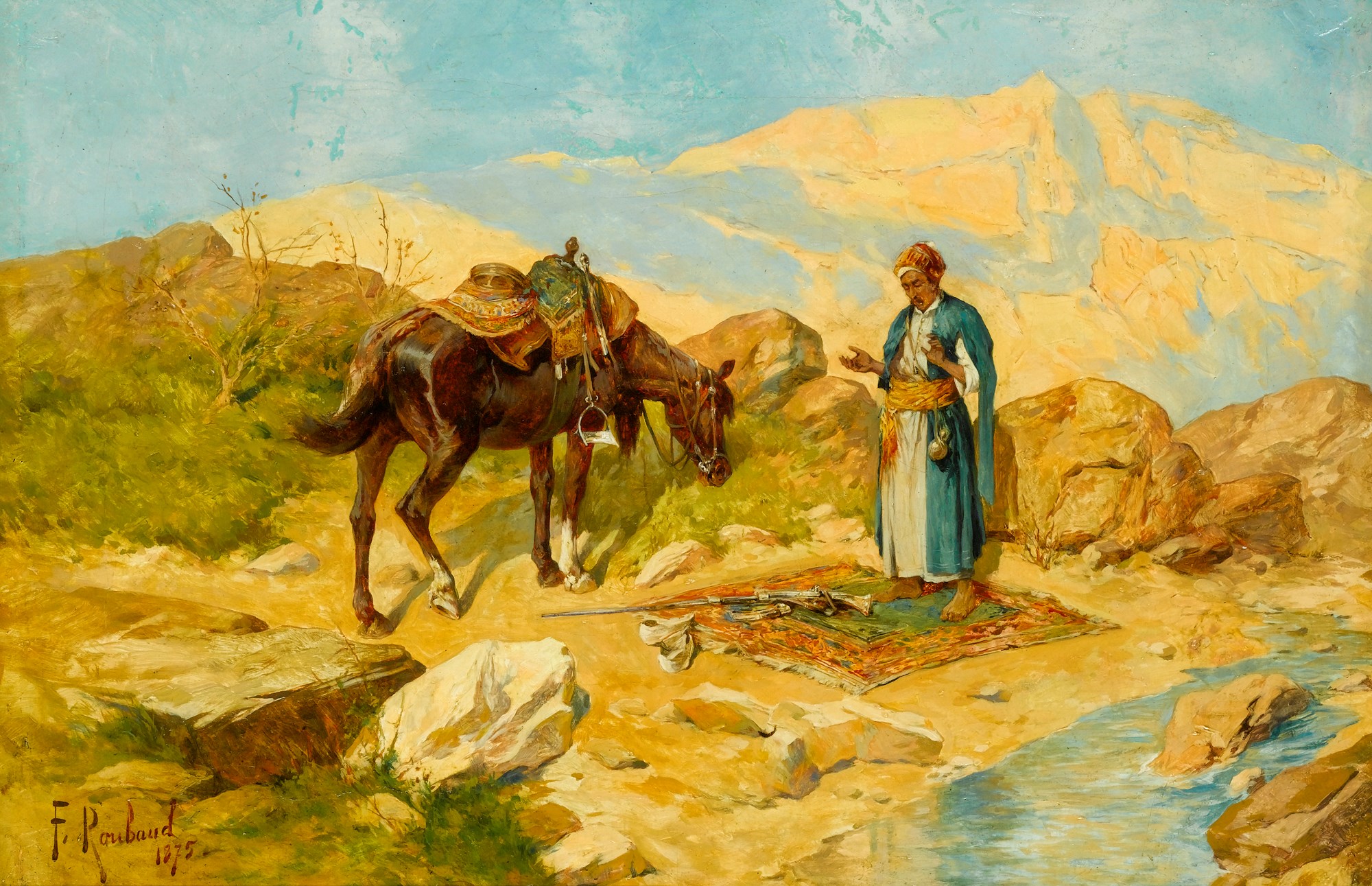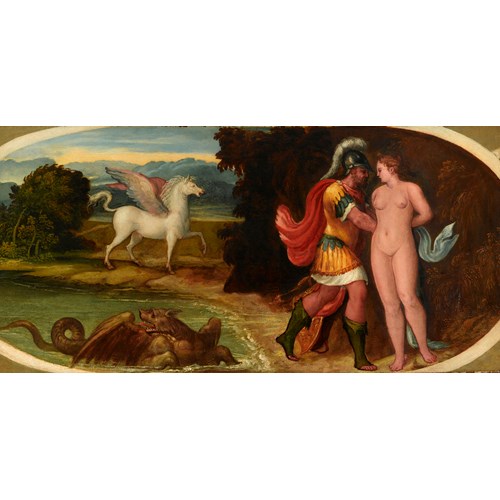Marketplace
The Hunter's Rest
Franz Alekseevich Roubaud
The Hunter's Rest
Date 1875
Period 1850-1900, 19th century
Origin Ukraine, Germany
Medium Oil on canvas
Dimension 33.3 x 49.2 cm (13¹/₈ x 19³/₈ inches)
The Hunter’s Rest is a marked departure from Frants Alekseevich Rubo’s historical paintings for which he is best known and, along with Study of a Cossack and Lone Cossack Horseman is part of a number of other works he executed of the varied cultures and people of the Caucasus region. This calm painting by Rubo portrays a peaceful and very personal moment of reflection in the daily life of a hunter. As his horse rests and eats from the grassy bank, and with his gun laid down on his prayer rug, and his shoes removed, the bare footed hunter initiates part of his daily prayer, Salat. His hands are raised upwards as he begins, and his elaborately decorated prayer rug is laid out on the ground, facing Mecca.
Salat is one of the five pillars of Islam practiced by Muslims and is performed five times day: before sunrise, Salat al-fajr; at noon, Salat al-zuhr; the late part of the afternoon, as depicted here, Salat al-’asr; after sunset, Salat al-maghrib; and Salat al-’isha, between sunset and midnight. Though not required for prayer, the prayer mat helps to keep the worshipper clean -the only requirement in Islam is that prayers be performed in an area that is clean- and comfortable during the set positions and movements of prayer. The rugs are often patterned with geometric, floral, arabesque designs, or depict Islamic landmarks such as the Ka’aba in Mecca or Al-Aqsa Mosque in Jerusalem, while others are created from solid colours. The patterns, dyes and materials used are traditional to the region in which they were made. The worshipper stands at the bottom of the rug, and the top points towards the direction of prayer, Mecca; often the tops are adorned with a niche. The worshipper then kneels at the base of the rug and places his hands either side of the niche, touching it with his forehead at the various stages of prayer. After prayer, the rug is immediately rolled away, thus ensuring that it remains clean.
Rubo was born in the city of Odessa, and was the son of a French merchant who had moved to Russia. In 1865 at the age of nine, Rubo began studying at the School of Painting and Drawing in Odessa. In 1877 Rubo left for Munich where he entered the Bavarian Academy of Arts, under the guidance of the well-known battle painter Joseph von Brandt. During his period in Munich Rubo continued to return to Russia on his holidays, travelling around the Caucasus, Central Asia and the Ukraine.
In 1883 Rubo graduated from the Academy of Arts. Considered a specialist in Caucasus in 1886 he was commissioned to create some works for the new Military and Historic Museum in Tiflis. The result was nineteen large scale works.
Whilst working on this series of pictures Rubo began to plan and create one of his panoramas Taking the Fortress of Akhulgo by Storm. This, his first ‘Panorama’, was shown in Munich and Paris, and then at the International Exhibition in Nizhny Novgorod (1896) and in Sebastopol (1909) and St. Petersburg (1911). This particular ‘Panorama’ no longer exists.
The second of Rubo’s panoramas was created in 1905 for the 50th anniversary of the Crimean War. This work brought him fame in many countries. Between 1904 and 1912 he studied at the Imperial Academy of Arts in St. Petersburg, where he was appointed Head of the Studio for Battle-Painting. He was an active painter in St. Petersburg and became an academician in 1908. He died in 1928 in Munich, Germany. Rubo left behind him numerous sketches, hundreds of battle scenes and other paintings, in addition to the three large battle panoramas.
Salat is one of the five pillars of Islam practiced by Muslims and is performed five times day: before sunrise, Salat al-fajr; at noon, Salat al-zuhr; the late part of the afternoon, as depicted here, Salat al-’asr; after sunset, Salat al-maghrib; and Salat al-’isha, between sunset and midnight. Though not required for prayer, the prayer mat helps to keep the worshipper clean -the only requirement in Islam is that prayers be performed in an area that is clean- and comfortable during the set positions and movements of prayer. The rugs are often patterned with geometric, floral, arabesque designs, or depict Islamic landmarks such as the Ka’aba in Mecca or Al-Aqsa Mosque in Jerusalem, while others are created from solid colours. The patterns, dyes and materials used are traditional to the region in which they were made. The worshipper stands at the bottom of the rug, and the top points towards the direction of prayer, Mecca; often the tops are adorned with a niche. The worshipper then kneels at the base of the rug and places his hands either side of the niche, touching it with his forehead at the various stages of prayer. After prayer, the rug is immediately rolled away, thus ensuring that it remains clean.
Rubo was born in the city of Odessa, and was the son of a French merchant who had moved to Russia. In 1865 at the age of nine, Rubo began studying at the School of Painting and Drawing in Odessa. In 1877 Rubo left for Munich where he entered the Bavarian Academy of Arts, under the guidance of the well-known battle painter Joseph von Brandt. During his period in Munich Rubo continued to return to Russia on his holidays, travelling around the Caucasus, Central Asia and the Ukraine.
In 1883 Rubo graduated from the Academy of Arts. Considered a specialist in Caucasus in 1886 he was commissioned to create some works for the new Military and Historic Museum in Tiflis. The result was nineteen large scale works.
Whilst working on this series of pictures Rubo began to plan and create one of his panoramas Taking the Fortress of Akhulgo by Storm. This, his first ‘Panorama’, was shown in Munich and Paris, and then at the International Exhibition in Nizhny Novgorod (1896) and in Sebastopol (1909) and St. Petersburg (1911). This particular ‘Panorama’ no longer exists.
The second of Rubo’s panoramas was created in 1905 for the 50th anniversary of the Crimean War. This work brought him fame in many countries. Between 1904 and 1912 he studied at the Imperial Academy of Arts in St. Petersburg, where he was appointed Head of the Studio for Battle-Painting. He was an active painter in St. Petersburg and became an academician in 1908. He died in 1928 in Munich, Germany. Rubo left behind him numerous sketches, hundreds of battle scenes and other paintings, in addition to the three large battle panoramas.
Date: 1875
Period: 1850-1900, 19th century
Origin: Ukraine, Germany
Medium: Oil on canvas
Signature: Signed and dated ‘F. Roubaud/1875’ (lower left)
Dimension: 33.3 x 49.2 cm (13¹/₈ x 19³/₈ inches)
More artworks from the Gallery









